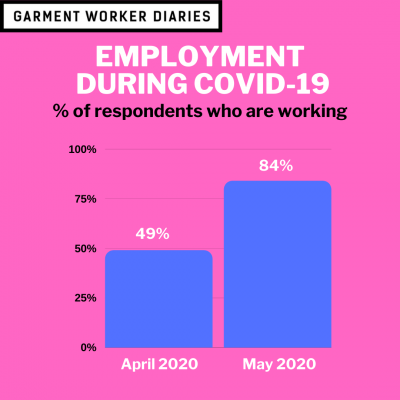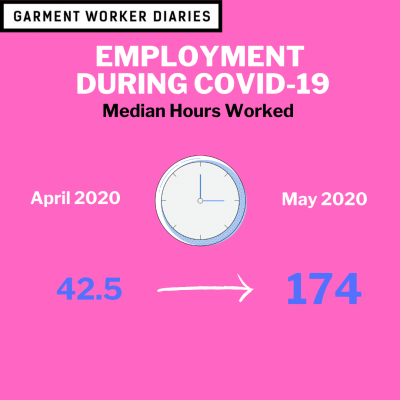In April and May 2020 garment workers in Bangladesh were living through the COVID-19 pandemic. In that time span MFO and SANEM conducted phone interviews with 1,377 of them in order to understand, in their own words, how they were responding to the situation, and whether COVID-19 was having an impact on their lives and livelihoods.
Two months in, we thought it would be a good time to step back and take a look at the journey the workers have been on. Are we seeing any short-term changes compared to the time before COVID-19? How about the most recent June 2020 data? Let’s see what garment workers are telling us.
Employment
- In April 2020, 49% of respondents worked, but those who did work only worked a median of 42.5 hours in the entire month, less than they normally work in a week.
- By May 84% reported they had worked some time during the month and the median hours worked had more than quadrupled to 174 hours.
- During the first week of May 76% of workers reported going to work and the median hours worked for the week stood at 54, a regular working week in Bangladesh.
- During the second and third weeks 81% and 80% of workers, respectively, reported going to work and the weekly median hours worked remained at 54.
- During the fourth week of May, due to the Eid festivities, 56% of workers reported going to work with the median hours worked for that week dropping to 18.
- But we may be seeing signs that COVID-19 is having an impact on employment in June.
- During the most recent week for which we have data, the second week of June 2020, 15% of respondents reported they did not work,
- 38% of those who did not work indicated it was for COVID-19-related reasons—closed factory, layoff, home quarantine, suspended, etc..
- There’s also a small but increasing number of respondents reporting going to work but who have recently changed factories due to COVID-19 related circumstances, such as being laid off or their factories closing.
Getting Paid
- In the RMG sector in Bangladesh workers are paid monthly for work they did in the previous month. In April 2020, 88% of respondents told us they received their salary. This did not change in May—88% of workers reported receiving a salary, even though half of the workers we interviewed in May reported not working in April.
- But the amount they got paid in May, a median of Tk. 5,522 was much less than in April, a median of 9,500 Tk.
- Men continue to receive a higher salary than women, in April the median salary paid to a man was Tk. 975 higher than the median salary paid to a woman. In May it was Tk. 200 higher.
- In April 2020, 28% of respondents received their salary digitally. In May 2020, this number increased to 76%.
- We initially reported in mid-May that 82% of workers were paid digitally. But we noticed that the likelihood of receiving a cash salary payment increased in the latter part of May, thus reducing the overall share of workers being paid digitally in the whole of May.
Food Security
- In April 2020, 97% of respondents reported that they ate less than they felt they should have because there wasn’t enough money for food. This number had fallen to 90% by May 2020.
- In May we decided to get more detail on food security and added questions about other members of the household. This is what we have learned so far:
- When asked if the head of the household had foregone food in May 2020, 85% of respondents reported that this was the case
- When asked if their children had foregone food due to lack of money, 37% of respondents with children reported this had occurred
Illness
- We have seen an increase in the share of workers reporting an illness in their household some time during the month.
- In April 2020, 19% of respondents reported they or a member of their household was ill some time during the month:
- 45% of those reporting an illness in April 2020 said they themselves were sick
- 52% of respondents reporting they themselves were sick were women, compared to 26% of men reporting they were sick
- 31% of illness cases involved sick children
- 87% of respondents reporting illness in April 2020 said that medical attention was sought
- 45% of those reporting an illness in April 2020 said they themselves were sick
- In May 2020, the number of respondents reporting an illness in the household at any time during the month rose to 31%
- 70% of those reporting an illness in May 2020 said they themselves were sick
- Women continued to report their own illness more than men, at a rate of 74% compared to 59%
- The number of reported illness cases involving children fell to 16% in May 2020
- 94% of respondents reporting illness in May 2020 said that medical attention was sought
- 70% of those reporting an illness in May 2020 said they themselves were sick
All data presented here come from interviews conducted over the phone with a pool of 1,377 workers. In April 2020, a total of 800 garment workers were enrolled in the study, and by the end of May 2020 this amount had grown to 1,377. The data received in May from the 800 workers that have been part of the sample since April, was compared with the data received from the full 1,377 sample and no discernible differences were found. For the early June data, 1,370 workers were interviewed. These workers are employed in factories spread across the five main industrial areas of Bangladesh (Chittagong, Dhaka City, Gazipur, Narayanganj, and Savar). Just over three-quarters of the working respondents are women, roughly representative of workers in the sector as a whole.





